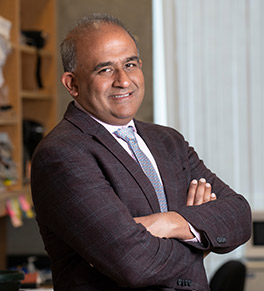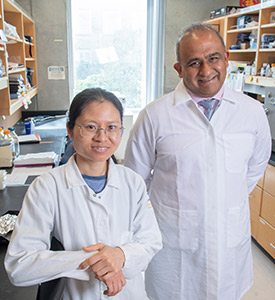Finding the genetic switch to stop tumor growth

“We’ve created a new chemical that’s never been made before," says UCI Health dermatologist and skin cancer researcher Dr. Anand Ganesan. "We show how this drug works and that it slows cancer growth.” Photo by Steve Zylius / UCI
Dr. Anand Ganesan probably won’t be hanging from a ceiling à la Tom Cruise in "Mission: Impossible," but the UCI Health dermatologist, co-creator of a promising new molecular compound to treat melanoma and other cancers, does compare part of his work to a plot device in the 1996 spy thriller.
“You know where the guy opens the switch box, there are all these wires coming down, and he’s trying to figure out which wire to cut to stop something bad from happening?" says Ganesan. "That’s what we’re trying to do: Cut the right wire to short-circuit cancer.”
Being a cancer researcher pays dividends for his patients and those of other UCI Health dermatologists, says the UCI School of Medicine professor of dermatology and biological sciences and co-leader of the Biotechnology, Imaging and Drug Development program at the UCI Health Chao Family Comprehensive Cancer Center.
Unlike other health systems in Orange County, UCI Health has a long roster of physicians who double as world-class researchers in their specialties, he notes.
“Most doctors don’t know how a drug is developed and what goes into the thought process of doing that. Knowing that really helps guide my practice a lot more.”
Fulfilling a mission
Not to mix Tom Cruise movies, but Ganesan is a top gun when it comes to fulfilling the cancer center's goals, which include:
- Facilitating and promoting interdisciplinary and transdisciplinary cancer research across UCI and UCI Health
- Disseminating state-of-the-art cancer knowledge to caregivers, patients, their families and the public
- Training the next diverse generation of cancer researchers and care providers
- Delivering the highest quality, multidisciplinary clinical care to cancer patients
That would not be possible, he says, without grants from the National Institutes of Health (NIH) and the UCI Anti-Cancer Challenge, which helped pave the way for his decade-plus research effort to identify genes that are activated in cancer and to develop ways to prevent those genes from sending signals that spur the disease.
In fact, about $40,000 in seed money for Ganesan's team came from the UCI Anti-Cancer Challenge, an annual ride-run-walk event to raise awareness and funds for pilot studies at the cancer center. With substantially more funding from the NIH, the Ganesan lab helped create the new molecular compound to block the spread of melanoma — one that may have broad applications for other tumor types, as reported in April in the journal Cell Reports.
Driving innovation
Such breakthroughs are possible because of UC Irvine's deep expertise in biology, mathematics, chemistry and other research areas, which the National Cancer Institute (NCI) recognized with a $10 million, five-year grant. That resulted in the creation of the UCI Center for Cancer Systems Biology, one of only 13 centers nationwide to join the NCI’s Cancer Systems Biology Consortium.
“Our mission is to translate the findings of our research into treatments that can benefit patients, driven by a strong commitment to scientific discovery and clinical innovation,” cancer center Director Richard A. Van Etten, MD, PhD, has said. “Institutions lacking their own research base can follow and adopt advances developed at NCI centers like ours, but they cannot lead in the same way as comprehensive cancer centers that integrate research with clinical care.”
For an idea of how this drive for discovery has played out for Ganesan and his lab team, their latest research builds on a 2017 Cell Reports study on the discovery of a key mutation in melanoma cells that helps them evade the body's immune system. That in turn grew out of their 2012 Cancer Research paper, which identified the cause of chemotherapy resistance in melanoma.
Targeting melanoma
Melanoma gets top billing because it is what Ganesan and his fellow dermatologists in sunny Southern California deal with most frequently.
“Fortunately, 90% of melanoma is curable by surgery,” he says. “Almost two-thirds of the other 10% of cases we see are what we call stage III disease, which means the tumor has moved to the lymph node but hasn’t moved to the rest of the body. The rest have tumor cells that moved elsewhere in the body.”
Ganesan and his fellow researchers are focused on developing new therapies for patients with advanced stage III tumors.
“The strategy scientists have taken initially was to say, ‘OK, these tumors have the same mutations as the metastatic tumors, so the immune system is potentially activated in the same way,’ ” he explains.
“But mutation-directed therapies and immunotherapies for patients with metastatic tumors have side effects. Can we think of a way that we can target these tumors in a more direct fashion, targeting their ability to move, that is more selective than for those that are starting to metastasize?”
Step one was establishing a genetic strategy, the focus of Ganesan's 2012 paper, which identified a class of genes called CDC42 that are important in chemotherapy resistance as well as the functioning of some genes in tumor progression.
“These genes are like switches,” he says, returning to the "Mission: Impossible" scenario.
“We use the genetic approach to find out which wire is important or which signaling pathway is important. The next logical question is how do we cut it? How do we target the right switch? Switches go on and off, on and off, on and off, all the time. But they only do something that induces cancer when they’re on. So how can we develop a drug compound to target these switches when they are on?”
A chance meeting
It was a question perplexing Ganesan when he happened to be in Italy and met Marco De Vivo, group leader of the Molecular Modeling & Drug Discovery Lab at the Italian Institute of Technology (IIT) in Genoa and co-creator of the new molecule.
“I told him what I was working on,” he recalls. “I said, ‘The switch is important, but how do I target it? How do I make a cancer drug out of it?’ He said, ‘Oh, I think I could do that.’ And we started working together.”
Based on computational models, the collaborators eventually identified a primary molecule to target the switch and developed a drug that would bind to the molecule and prevent it from signaling the cancer's growth. Ganesan says the research by IIT and his lab offers hope to stage III melanoma patients who previously would have “fallen through the cracks.”
“We’ve made a new chemical that has never been seen before,” he says. “We show how this drug works and that it slows cancer growth. But there’s still a journey from having a drug that does this in our models and having a drug we can give to people. That’s the path we’re on right now.”
To take the leap from academic research to clinical therapy, Ganesan, De Vivo and two other partners started Alyra Therapeutics to develop the compound for human application. The startup is currently in fundraising mode.
A patient-driven approach
To further explain how his research helps him as a practicing dermatologist, Ganesan shifts to a pool hall metaphor.
“Great pool players line up three shots ahead of the shot they are playing,” he says. “The ball is here and they want to stop it in the right place so they can play the next ball and stop that shot so they can play the next one. That’s the way I think about drugs for patients. You are trying to figure out what the patient will respond to best — that’s your first shot — and when that person responds or does not, what do you do next? That’s your next shot. You have all your shots lined up before you take the first one.”
As a drug developer, Ganesan goes through the same process.
“You hit the ball into the first pocket and it bounces off where you want to line up the second shot,” he explains. “How are you going to get there? That’s kind of the way I think about things. It’s not just for melanoma or patient diagnostics, it's also for other diseases I treat. Conducting research has really changed the way I think and how I care for patients.”
Coming up with therapies to make melanoma and other diseases he treats less prevalent is what drives Ganesan's research. Because patients treated for melanoma often see the disease return at some point, he is trying to find ways to keep it from spreading in the first place. One way his team is doing that is by refining their approach with theranostics, in which imaging guides the diagnosis and development of therapies that are personalized for each patient.
“We are trying to apply theranostics to melanoma,” he says. “Immunotherapy is the gold standard of treatment. What that does is make the immune system fight the tumor and the tumor goes away. And when that happens, it’s amazing because it could be a lifelong cure.”





